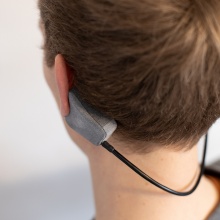People who suffer from the very rare congenital central hyperventilation syndrome (CCHS, which was once known as Ondine’s curse) have no real breathing reflex and suffocate when falling asleep. While persons affected by the disease can be monitored at night, a nap during the day can be dangerous. With the support of the Eva Mayr Stihl Foundation, researchers at the University of Stuttgart have developed a system that is designed to enable patients to live autonomously in everyday situations when they become drowsy. The small device named “WakeMe” continuously measures the oxygen saturation of the blood and wakes the patient when the level falls below a critical threshold value.
From circulation to the reflexes: Breathing is central to many vital functions and runs autonomously. While automatic breathing can be controlled when you are awake, it is modulated exclusively by chemical stimuli and autonomic reflexes when you are asleep. If the carbon dioxide concentration in the blood becomes too high, CO2-specific chemoreceptors react and a respiratory stimulus occurs. In CCHS patients, this stimulus is absent. When they fall asleep without artificial respiration, the oxygen level in their blood decreases steadily - which leads to unconsciousness and death if the apnea persists.
At night, the patients are being monitored and artificially ventilated. However, in case they fall asleep during the day, there is currently no monitoring and alarm system available. For these “drowsy everyday situations”, researchers at the Institute of Medical Device Technology (IMT) at the University of Stuttgart developed the system “WakeMe” in cooperation with persons affected, and with the support of the Eva Mayr Stihl Foundation. The device continuously monitors the oxygen saturation in the blood, reliably wakes the person up when the level falls below a threshold, and reminds them to breathe.
Small, inconspicuous, and easy to use
The small device, which weighs just under 20 grams, is worn inconspicuously behind the ear and is easy to use. It includes a microcontroller, a sensor for measuring oxygen saturation and heart rate, and an alarm system that consists of one loudspeaker and one vibration motor on each side. In addition, there is a mobile charging and storage case that ensures nine hours of operation as well as safe transport, for example, on the way to school.
“WakeMe” was developed at the IMT within the framework of two student research projects and in close cooperation with health professionals and persons affected. The next steps include a usability study of the prototype and initial trials with those affected. In addition, cooperation partners are sought that support the project, so that the scientists can make the device available to persons affected.
Expert Contact:
Prof. Dr. Peter P. Pott, University of Stuttgart, Institute of Medical Device Technology (IMT), phone +49 711 685 68390, E-Mail




